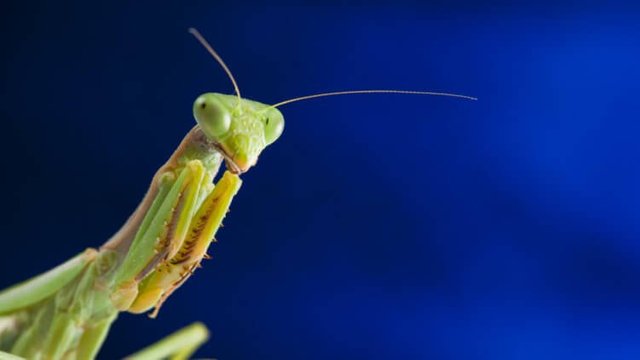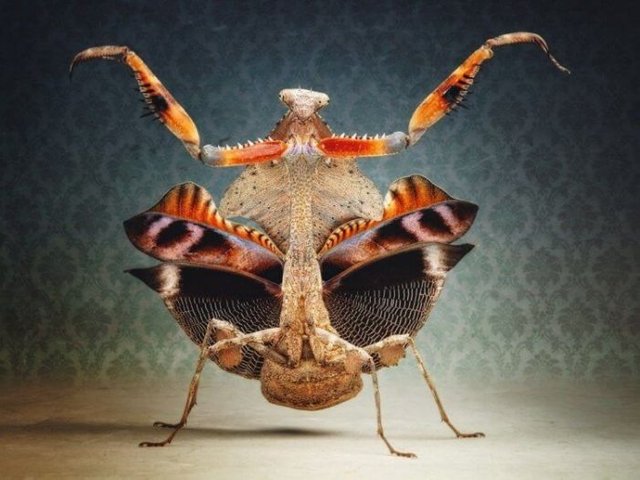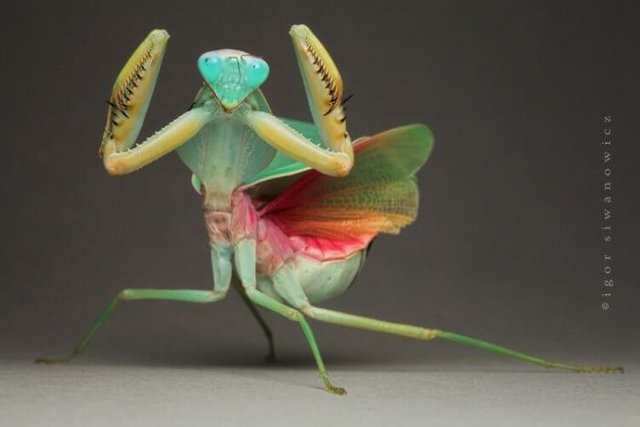
These ferocious insects with strange eyes are excessively gluttonous and, to be honest, cause hostility. For man, praying mantises are not dangerous and are very interested in scientists. By the way, before writing this article, all I knew about these terrible insects is that the females bite their heads off to the males immediately after mating. Agree, this is somewhat unusual behavior. And the results of a new study do say that we know these insects very poorly. In this article, you will learn why mantises are more skilled predators than we thought.
Praying mantises are the only living creatures on our planet that can turn their heads 360 degrees. Horror!
Mantis - unusual insects
To begin with, mantises are large predatory insects with forepaws adapted to capture food. Scientists distinguish mantis in the eponymous squad of the Mantis, which has a total of 2853 species. By the way, they owe their unusual name not to an angelic character and good disposition, but to a special hunting pose in which they fold their front paws, like a person who prays to God. For the first time, the outstanding Swedish naturalist Karl Liney drew attention to this back in 1758. By the way, the Latin name of the mantis sounds like "Mantis religiosa", which literally translates as "religious priest."
It is noteworthy that not everywhere a mantis is called a mantis, excuse me for the tautology. For example, in Spain, these insects are known as Caballito del Diablo - the devil’s horse or simply - muerte - death. And most importantly, these names are associated with no less terrible and cruel habits of the mantis.
Male mantis reach a length of up to 52 mm, and females up to 75 mm. Another feature of these insects is their ability to disguise themselves as a variety of plants.
Be that as it may, the long, tenacious legs of the mantis, the color and shape of some species involuntarily attract the eye. So, Hymenopus coronatus, an orchid mantis is barely distinguishable from a flower, and the pearly color, disguising it as orchid flowers, is completely amazing. It is noteworthy that males of this species are almost half the size of females. Researchers note that some insects have acquired a striking appearance for the sake of camouflage, others to attract the opposite sex, others to scare away enemies.

Hymenopus coronatus - self orchid mantisIt should be noted that almost all types of mantis are equipped (if you can say so about them) with well-developed wings. True, males fly mainly. This is because females are traditionally bigger and heavier, which means flying them is clearly not so simple. These unusual predators feed on both smaller insects and larger insects. Everyone eats food - wasps, butterflies, flies, bumblebees, bees, bugs, etc. I don’t know about you, but least of all in the world I would like to meet mantis that feed on birds and small amphibians, such as lizards and frogs. Brr! But how exactly do mantises hunt?
How Mantis Hunt
According to a study published in Biology Letters, these ferocious insects do not just hunt like robots. Everything is much, much worse, the mantises calibrate their attacks in order to more effectively capture prey when it flies past - and at different speeds.
According to the New York Times, predatory animals are traditionally divided into two categories, depending on how they catch prey. The first group chases predators and knocks them down (as cheetahs and other large predators usually hunt). The second group is better known as waiting predators - they hide in anticipation of the right moment, and then instantly strike.

Heterochaeta orientalis or Heteroheta eastern, it reaches 16 cm in lengthHowever, recently this point of view has been called into question. By studying mantis shrimps that capture prey with an ultrafast punch, scientists have found that these insects control the speed of the punch! And the results of a 2016 study of praying mantises showed that they show flexibility in the “catching" of fixed insects.
During the experiment, the researchers placed one Madagascar marble praying mantis on a raised platform under bright light. Then they directed the prey - either a dead beetle, or a bead similar to it - towards the mantis on a transparent wire. The target could move at three speeds, each of which was supposed to approach a different type of mantis prey. The slowest of them - 200 millimeters per second - is the average speed of the fruit fly. The fastest - 730 millimeters per second - simulated a falling fly. The authors of the work placed eight different praying mantises through dozens of swings, shooting each of them on a high-speed camera. Then they analyzed the recorded movements of insects.

Rhombodera basalis, Malaysian shield mantisThe results showed that the mantis strike has two phases: in the first phase, the mantis extends its legs up and out. In the second phase - the phase of the sweep, the mantis grabs prey from the air and draws it to itself to eat.
So, it turned out that the mantis really adjusts the speed of the blow depending on how fast the prey moves. As the researchers write in their work, given that some strokes last less than one tenth of a second, this is very unusual. Moreover, the results of the study again raise the question of what insects are capable of and whether we know them so well, as it seems to us.
They are not that bad as pictured! Please join us at https://commun.com/?invite=cmn1lzzofrkz - a new social platform on CyberWay blockchain on a Science community and get your donations from the very first day! :)
Downvoting a post can decrease pending rewards and make it less visible. Common reasons:
Submit